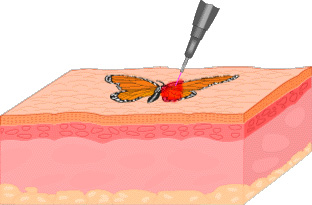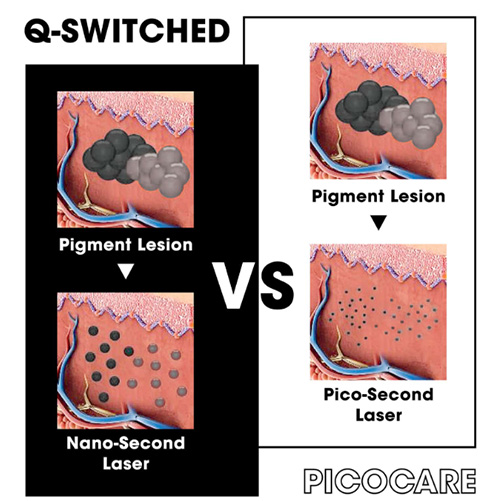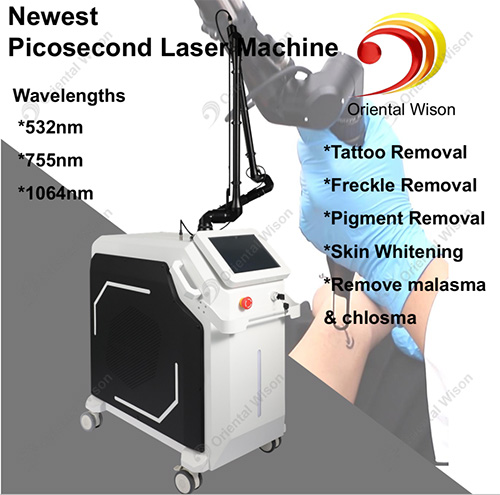Why choose a picosecond laser?
2025-03-03
 Picosecond laser uses very short pulse output mode, by the principle of light mechanical shock wave, pigment is "shattered" into finely granular via focused energy, are more likely to be absorbed by the body metabolism. Picosecond laser will be to minimize the side effects of thermal effect, can achieve the goal of almost solve all kinds of pigment spots.
Picosecond laser uses very short pulse output mode, by the principle of light mechanical shock wave, pigment is "shattered" into finely granular via focused energy, are more likely to be absorbed by the body metabolism. Picosecond laser will be to minimize the side effects of thermal effect, can achieve the goal of almost solve all kinds of pigment spots.
The effect of spot whitening,tattoo removal,skin rejuvenation,fine lines removal,freckles, sunburn, age spots etc, is better than traditional laser.
Comparing Q-Switched Nd:YAG vs Picosecond Laser

Both Q-switched Nd:YAG laser and Picosecond Laser are very similar in their applications. However, there are some key differences:
The main difference between the two lasers is the pulse duration. Q-Switched Nd:YAG Laser has a pulse duration of nanoseconds, while Picosecond Laser has a much shorter pulse duration of picosecond .
This means that Picosecond Laser can deliver shorter, more powerful bursts of energy, allowing for faster and more precise treatment. Yet Q-Switched Nd:YAG Laser can provide a wider range of pigmentation treatments.
In comparison to traditional lasers, the Picosecond Laser treatment is non-intrusive, making it safer as the skin damage is particularly minimal and does not impact the surrounding tissues during the treatment. Hence, there are fewer complications when it comes to scarring, burning, and pigmentation side effects. Traditional lasers such as Q-Switched lasers can be unsuccessful regarding certain skin types, while the Picosecond Laser is suitable for all skin types due to its precision.
To summarise, Picosecond Laser may be a better option for those looking for faster and more precise results.

What are some of the benefits of Picosecond Laser?l 3 Laser Wavelengths in one handle
1- 1064nm: removes all dark colors including dark brown, dark navy, gray & black ink
2- 532nm: removes colorful pigment, like red & green ink, pigment and birthmarks
3- 755nm: removes dark colors including dark brown, dark navy, gray & black inkl Reduction of Fine Lines, Wrinkles, Dark Spots, and Improved Skin Rejuvenation
The Picosecond laser utilises skin resurfacing to mark the dermal skin layers to activate elastin and collagen production, in comparison to traditional laser treatments, that tend to burn away your skin and then force it to heal.
Effective Tattoo Removal
Picosecond laser utilise both light and heat waves to break apart the ink. Combined with the faster, shorter energy pulses, this diminishes the possibility of thermal ink damage while ensuring that it is a far more efficient solution for tattoo removal.
Minimal Discomfort and No Recovery Downtime
Many patients have recounted experiencing the procedure as ‘rubber bands snapping' against the skin. Additionally, the individual may experience a mild tingling sensation due to the shock waves putting pressure in the dermal layers caused by the laser. Once the procedure is completed, they will either encounter no discomfort at all or a mild redness in the treated areas. This will clear up within a few hours.

 Whatsapp:8613811714803
Whatsapp:8613811714803
 English
English Español
Español Português
Português русский
русский Français
Français 日本語
日本語 Deutsch
Deutsch tiếng Việt
tiếng Việt Italiano
Italiano Nederlands
Nederlands ภาษาไทย
ภาษาไทย Polski
Polski 한국어
한국어 Svenska
Svenska magyar
magyar Malay
Malay বাংলা ভাষার
বাংলা ভাষার Dansk
Dansk Suomi
Suomi हिन्दी
हिन्दी



